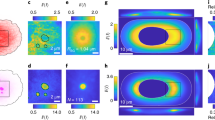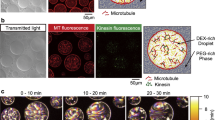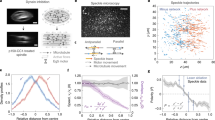Abstract
Liquid–liquid phase separation1,2 occurs not only in bulk liquid, but also on surfaces. In physiology, the nature and function of condensates on cellular structures remain unexplored. Here we study how the condensed protein TPX2 behaves on microtubules to initiate branching microtubule nucleation3,4,5, which is critical for spindle assembly in eukaryotic cells6,7,8,9,10. Using fluorescence, electron and atomic force microscopies and hydrodynamic theory, we show that TPX2 on a microtubule reorganizes according to the Rayleigh–Plateau instability, like dew droplets patterning a spider web11,12. After uniformly coating microtubules, TPX2 forms regularly spaced droplets, from which branches nucleate. Droplet spacing increases with greater TPX2 concentration. A stochastic model shows that droplets make branching nucleation more efficient by confining the space along the microtubule where multiple necessary factors colocalize to nucleate a branch.
This is a preview of subscription content, access via your institution
Access options
Access Nature and 54 other Nature Portfolio journals
Get Nature+, our best-value online-access subscription
$29.99 / 30 days
cancel any time
Subscribe to this journal
Receive 12 print issues and online access
$209.00 per year
only $17.42 per issue
Buy this article
- Purchase on Springer Link
- Instant access to full article PDF
Prices may be subject to local taxes which are calculated during checkout




Similar content being viewed by others
Data availability
Source data are provided with this paper. All other data that support the plots within this paper and other findings of this study are available from the corresponding author upon reasonable request.
Code availability
Algorithms and simulation codes are described in Methods and Supplementary Information.
References
Shin, Y. & Brangwynne, C. P. Liquid phase condensation in cell physiology and disease. Science 357, eaaf4382 (2017).
Alberti, S., Gladfelter, A. & Mittag, T. Considerations and challenges in studying liquid–liquid phase separation and biomolecular condensates. Cell 176, 419–434 (2019).
Petry, S., Groen, A., Ishihara, K., Mitchison, T. & Vale, R. Branching microtubule nucleation in Xenopus egg extracts mediated by augmin and TPX2. Cell 152, 768–777 (2013).
Thawani, A., Stone, H. A., Shaevitz, J. W. & Petry, S. Spatiotemporal organization of branched microtubule networks. eLife 8, e43890 (2019).
King, M. R. & Petry, S. Phase separation of TPX2 enhances and spatially coordinates microtubule nucleation. Nat. Commun. 11, 270 (2020).
Uehara, R. & Goshima, G. Functional central spindle assembly requires de novo microtubule generation in the interchromosomal region during anaphase. J. Cell Biol. 191, 259–267 (2010).
Uehara, R. et al. The augmin complex plays a critical role in spindle microtubule generation for mitotic progression and cytokinesis in human cells. Proc. Natl Acad. Sci. USA 106, 6998–7003 (2009).
Petry, S., Pugieux, C., Nédélec, F. J. & Vale, R. D. Augmin promotes meiotic spindle formation and bipolarity in Xenopus egg extracts. Proc. Natl Acad. Sci. USA 108, 14473–14478 (2011).
Lawo, S. et al. HAUS, the 8-subunit human augmin complex, regulates centrosome and spindle integrity. Curr. Biol. 19, 816–826 (2009).
Hotta, T. et al. Characterization of the Arabidopsis augmin complex uncovers its critical function in the assembly of the acentrosomal spindle and phragmoplast microtubule arrays. Plant Cell 24, 1494–1509 (2012).
Rayleigh, L. On the instability of jets. Proc. Lond. Math. Soc. 1, 4–13 (1878).
Quéré, D. Fluid coating on a fiber. Annu. Rev. Fluid Mech. 31, 347–384 (1999).
Pérez de Castro, I. & Malumbres, M. Mitotic stress and chromosomal instability in cancer: the case for TPX2. Genes Cancer 3, 721–730 (2012).
Uhlen, M. et al. A pathology atlas of the human cancer transcriptome. Science 357, eaan2507 (2017).
Hernández-Vega, A. et al. Local nucleation of microtubule bundles through tubulin concentration into a condensed tau phase. Cell Rep. 20, 2304–2312 (2017).
Siahaan, V. et al. Kinetically distinct phases of tau on microtubules regulate kinesin motors and severing enzymes. Nat. Cell Biol. 21, 1086–1092 (2019).
Jiang, H. et al. Phase transition of spindle-associated protein regulate spindle apparatus assembly. Cell 163, 108–122 (2015).
von Appen, A. et al. LEM2 phase separation promotes ESCRT-mediated nuclear envelope reformation. Nature 582, 115–118 (2020).
Wühr, M. et al. Deep proteomics of the Xenopus laevis egg using an mRNA-derived reference database. Curr. Biol. 24, 1467–1475 (2014).
Alfaro-Aco, R., Thawani, A. & Petry, S. Biochemical reconstitution of branching microtubule nucleation. eLife 9, e49797 (2020).
Desai, A. & Mitchison, T. J. Microtubule polymerization dynamics. Annu. Rev. Cell Dev. Biol. 13, 83–117 (1997).
Goren, S. L. The instability of an annular thread of fluid. J. Fluid Mech. 12, 309–319 (1962).
Boulogne, F., Pauchard, L. & Giorgiutti-Dauphiné, F. Instability and morphology of polymer solutions coating a fibre. J. Fluid Mech. 704, 232–250 (2012).
Haefner, S. et al. Influence of slip on the Plateau–Rayleigh instability on a fibre. Nat. Commun. 6, 4–9 (2015).
Tonon, G. et al. High-resolution genomic profiles of human lung cancer. Proc. Natl Acad. Sci. USA 102, 9625–9630 (2005).
Neumayer, G., Belzil, C., Gruss, O. J. & Nguyen, M. D. TPX2: of spindle assembly, DNA damage response, and cancer. Cell. Mol. Life Sci. 71, 3027–3047 (2014).
Cao, L. et al. The structure of apo-kinesin bound to tubulin links the nucleotide cycle to movement. Nat. Commun. 5, 5364 (2014).
Shang, Z. et al. High-resolution structures of kinesin on microtubules provide a basis for nucleotide-gated force-generation. eLife 3, e04686 (2014).
Gillespie, D. T. Exact stochastic simulation of coupled chemical reactions. J. Phys. Chem. 81, 2340–2361 (1977).
Caudron, M., Bunt, G., Bastiaens, P. & Karsenti, E. Spatial coordination of spindle assembly by chromosome-mediated signaling gradients. Science 309, 1373–1376 (2005).
Brugués, J., Nuzzo, V., Mazur, E. & Needleman, D. J. Nucleation and transport organize microtubules in metaphase spindles. Cell 149, 554–564 (2012).
Decker, F., Oriola, D., Dalton, B. & Brugués, J. Autocatalytic microtubule nucleation determines the size and mass of Xenopus laevis egg extract spindles. eLife 7, e31149 (2018).
Feric, M. et al. Coexisting liquid phases underlie nucleolar subcompartments. Cell 165, 1686–1697 (2016).
Duprat, C., Protiere, S., Beebe, A. & Stone, H. A. Wetting of flexible fibre arrays. Nature 482, 510–513 (2012).
Li, Q. et al. LLPSDB: a database of proteins undergoing liquid–liquid phase separation in vitro. Nucleic Acids Res. 48, D320–D327 (2020).
Alfaro-Aco, R., Thawani, A. & Petry, S. Structural analysis of the role of TPX2 in branching microtubule nucleation. J. Cell Biol. 216, 983–997 (2017).
Song, J. et al. Mechanism of how augmin directly targets the γ-tubulin ring complex to microtubules. J. Cell Biol. 217, 2417–2428 (2018).
Murray, A. W. & Kirschner, M. W. Cyclin synthesis drives the early embryonic cell cycle. Nature 339, 275–280 (1989).
Hannak, E. & Heald, R. Investigating mitotic spindle assembly and function in vitro using Xenopus laevis egg extracts. Nat. Protoc. 1, 2305–2314 (2006).
Case, R. B., Pierce, D. W., Hom-Booher, N., Hart, C. L. & Vale, R. D. The directional preference of kinesin motors is specified by an element outside of the motor catalytic domain. Cell 90, 959–966 (1997).
Gell, C. et al. in Methods in Cell Biology Vol. 95 (eds Wilson, L. & Correia, J. J.) 221–245 (Elsevier, 2010).
Schindelin, J. et al. Fiji: an open-source platform for biological-image analysis. Nat. Methods 9, 676–682 (2012).
Hamon, L., Curmi, P. A. & Pastré, D. in Methods in Cell Biology Vol. 95 (eds Wilson, L. & Correia, J. J.) 157–174 (Elsevier, 2010).
Nečas, D. & Klapetek, P. Gwyddion: an open-source software for SPM data analysis. Open Phys. 10, 181–188 (2012).
Thevenaz, P., Ruttimann, U. E. & Unser, M. A pyramid approach to subpixel registration based on intensity. IEEE Trans. Image Process. 7, 27–41 (1998).
Acknowledgements
We thank S. Lee, T.-M. Chou and M. Libera at Stevens Institute of Technology for access to their atomic force microscope; I. Armstrong and S. Dutta at Bruker for access to and support for their atomic force microscope; M. King, B. Bratton, M. Safari, M. Koch, P. Ronceray and N. Wingreen for discussions; A. Thawani for purification of TPX2; H. Ando, C. Holmes, physiology students V. Baena, D. Laundon and L. Ma, and the Physiology Course at the Marine Biological Lab for assisting with the first AFM trials; and Princeton’s Imaging and Analysis Center, which is partially supported by the Princeton Center for Complex Materials, an NSF-MRSEC programme (DMR-1420541). B.G. was supported by PD Soros and NSF GRFP. S.U.S. was supported by NIH NCI NRSA 1F31CA236160 and NHGRI training grant 5T32HG003284. This work was funded by NIH NIA 1DP2GM123493, Pew Scholars Program 00027340, Packard Foundation 2014-40376 and CPBF NSF PHY-1734030.
Author information
Authors and Affiliations
Contributions
S.U.S., B.G., J.W.S., H.A.S. and S.P. conceptualized the project. B.G. and S.U.S. performed fluorescence microscopy, and B.G. performed analysis of fluorescence microscopy data. B.G. performed TPX2-only electron microscopy with assistance from R.A.-A. and S.U.S., theory and simulations. S.U.S. and B.G. performed AFM, and S.U.S. performed analysis of AFM data. S.U.S. performed meiotic cytosol experiments. R.A.-A. performed branching reconstitution and multiple-protein electron microscopy, and S.U.S. performed analysis of branching reconstitution data. S.U.S. and B.G. wrote the paper with assistance from J.W.S., H.A.S. and S.P. J.W.S., H.A.S. and S.P. supervised the research. All authors discussed and interpreted results and revised the paper.
Corresponding authors
Ethics declarations
Competing interests
The authors declare no competing interests.
Additional information
Peer review information Nature Physics thanks Amy Gladfelter and the other, anonymous, reviewer(s) for their contribution to the peer review of this work.
Publisher’s note Springer Nature remains neutral with regard to jurisdictional claims in published maps and institutional affiliations.
Extended data
Extended Data Fig. 1 Statistics of droplet patterned microtubules imaged with TIRF microscopy.
a, Histogram of droplet sizes and spacings for TIRF experiments at 1 μM GFP–TPX2. N = 35 microtubules were analyzed with a mean size of 0.5 ± 0.1μm and spacing 0.6 ± 0.2μm (mean ± standard deviation). b, Average power spectrum of GFP–TPX2 fluorescence intensities of droplet patterns for TIRF experiments at 1 μM GFP–TPX2 (N = 35 microtubules). The peak indicates the emergence of a periodic pattern with wavelength \({\lambda }_{\max }=0.6\pm 0.1\,\mu {\rm{m}}\) (mean ± standard deviation), in agreement with the histogram analysis. Shaded regions are 95% bootstrap confidence intervals. For calculation details, see Methods.
Extended Data Fig. 2 TPX2 on the microtubule can appear uniform when imaged via optical microscopy.
a, TIRF microscopy time lapses showing that a 0.1 μM TPX2 coating does not break up into visible droplets like the 1 μM TPX2 coating does. b, Branching microtuble nucleation visualized by TIRF microscopy in X. laevis meiotic cytosol at 0.1 μM TPX2, indicating that branching can occur from diffraction limited droplets.
Extended Data Fig. 3 Raw and smoothed AFM height profiles, and power spectra of raw height profiles.
a, Raw height profiles of the topographies in Fig. 2a. The smoothed profile from Fig. 2b is shown again for reference. b, Power spectra of the raw height profiles in (a). The red curve shows the mean ± standard error of the mean over nine topographies of the microtubule after the droplet pattern had formed. The frequency f at which the peak in the red curve occurs gives the droplet spacing measured for this microtubule, according to λ = 1/f.
Extended Data Fig. 4 Schematic of the Rayleigh-Plateau instability.
The viscosity of the condensed film is μ, γ is the surface tension of the interface, and p∞ is the far field pressure provided by the solvent. The microtubule has radius ri. Initially, the interface is flat at \(\xi \left(z,t=0\right)={r}_{{\rm{o}}}\), but this scenario is unstable against the capillary pressure γ/ro, so \(\xi \left(z,t\right)\) will evolve to a lower energy state. The unit normal n and unit tangent t track the geometry of the interface during its evolution.
Extended Data Fig. 5 AFM height profiles and power spectra at additional TPX2 concentrations.
For 0.1 μM, the power spectrum is averaged over N = 5 topographies after the droplet pattern had formed. For 0.6 μM, N = 3. For 0.8 μM, N = 4; the uncoated height profile for this specific microtubule is unavailable because the sample moved after TPX2 addition. Height profiles were smoothed using a moving-average window of 40nm. All power spectra after droplet formation show mean ± standard error of the mean.
Extended Data Fig. 6 Growth of the condensed film.
a, Schematic of the model for growth of the condensed protein film. Microtubules of radius ri are spaced periodically by a distance \(2\bar{R}\), where \(\bar{R}=1/\sqrt{\pi nl}\) where l is the typical microtubule length and n is the number density of microtubules. Soluble protein phase separates from solution and nucleates a spatially uniform condensed film on the microtubule surface, whose interfacial position we denote by \(r=\xi \left(t\right)\). b, Final film thickness h versus initial concentration c0 as measured by atomic force microscopy (blue) and as predicted by equation (19) (black) and using \(1/{c}_{{\rm{R}}}\left({\bar{R}}^{2}/{r}_{{\rm{i}}}^{2}-1\right)\) as a least-squares fit parameter. c, Evolution of the interfacial position of the film ξ/ri over time T for \(S={r}_{{\rm{i}}}/{r}_{{\rm{o}}}\in \left[0.5,0.7\right]\), which is our experimentally observed range of S. Solid lines are the exact solution and dashed lines are the asymptotic formula (34b).
Extended Data Fig. 7 Average power spectra from AFM data for all concentrations of TPX2 and for uncoated, initially TPX2-coated, C-terminal-TPX2-bound, and kinesin-1-bound microtubules.
Peaks indicate characteristic wavelengths that correspond to a typical droplet spacing (Supplementary Table 3) (N = 25, 17, 23, and 21 microtubules, respectively, for increasing TPX2 concentration). Also included are average power spectra for uncoated microtubules (N = 29 microtubules), microtubules initially coated uniformly with TPX2 (N = 25 microtubules), kinesin-bound microtubules (N = 19 microtubules), and C-terminal-TPX2-bound microtubules (N = 4 microtubules)—none of which show any characteristic spatial features. For kinesin-bound microtubules, h = 2.9 ± 2.0nm, consistent with what one would expect for the kinesin construct used27,28. For C-terminal-TPX2-bound microtubules, h = 3.7 ± 1.8nm. Heights are mean ± standard deviation. Shaded regions represents 95% bootstrap confidence intervals.
Extended Data Fig. 8 The growth of the instability for early times is exponential.
The average spectral amplitude at the most unstable frequency grows exponentially for early times (black line, N = 21 microtubules). Spectral amplitude = \(\sqrt{{\rm{spectral}}\ {\rm{power}}}\). Individual measurements are black dots. Shaded region represents 95% bootstrap confidence intervals. At later times, the spectral amplitude levels off due to nonlinear forces as the pattern sets in. For the exponential fit (red), \({\sigma }_{\max }=0.03\,{\min }^{-1}\), with R2 = 0.95.
Extended Data Fig. 9 γ-TuRC localization on bare microtubules.
Typical electron microscopy experiment with just γ-TuRC and microtubules. Clearly, the localization of γ-TuRC to the microtubule without TPX2 and augmin is negligible (Supplementary Table 4). Scale bar is 100 nm.
Extended Data Fig. 10 Parametric study of Monte Carlo simulations.
a, Time τ to colocalize two distinct factors, and hence form a branch, as a function of N and s for a uniform and periodic protein coating. For a given s, the periodic coating is uniformly more efficient at colocalizing well-mixed factors. Each data point is the average of 107 independent simulations. b, Typical histogram of 107 independent simulations for F = 2, N = 50, and s = 10.
Supplementary information
Supplementary Information
Theoretical derivations, experimental materials and methods, Supplementary Tables 1–5 and references.
Supplementary Video 1
Rayleigh–Plateau instability of TPX2 on microtubules visualized using TIRF microscopy. GFP–TPX2 at 1 μM was spiked onto a passivated glass surface covered with Alexa568-labelled microtubules at t = 0 s. TPX2 coats the microtubules and then proceeds to break up into droplets. Scale bar, 1 μm.
Supplementary Video 2
Microtubule branches nucleating from TPX2 droplets on a preexisting microtubule. During acquisition, only the soluble tubulin channel was imaged to enable capturing nucleation and polymerization of branched microtubules at high temporal resolution. Scale bar, 5 μm.
Supplementary Video 3
Branching microtubule nucleation visualized using TIRF microscopy. TPX2 at 0.1 μM is added to X. laevis meiotic cytosol purified from eggs. TPX2 coats the mother microtubule, from which daughter microtubules then nucleate, leading to an autocatalytic branched network. The frame dimensions are 16 μm × 22 μm.
Supplementary Video 4
Rayleigh–Plateau instability of TPX2 on microtubules probed using AFM. GFP–TPX2 at 0.2 ± 0.1 μM was spiked onto a mica surface covered with microtubules during acquisition. The uniform film of TPX2 is established at t = 0 s, after which the film breaks up into droplets. The frame dimensions are 2 μm × 2 μm.
Source data
Source Data Fig. 2
AFM line scans and average power spectra.
Source Data Fig. 3
AFM wavelength versus film thickness data points and theory curve.
Source Data Fig. 4
Monte Carlo colocalization time data.
Source Data Extended Data Fig. 1
TIRF histogram data and average power spectrum.
Source Data Extended Data Fig. 3
Raw and smoothed AFM line scans; individual power spectra.
Source Data Extended Data Fig. 5
AFM line scans and power spectra.
Source Data Extended Data Fig. 6
Film thickness versus concentration data and fit curve.
Source Data Extended Data Fig. 7
All averaged AFM power spectra.
Source Data Extended Data Fig. 8
All averaged spectral amplitude versus time plots.
Source Data Extended Data Fig. 10
Monte Carlo colocalization time and histogram data.
Rights and permissions
About this article
Cite this article
Setru, S.U., Gouveia, B., Alfaro-Aco, R. et al. A hydrodynamic instability drives protein droplet formation on microtubules to nucleate branches. Nat. Phys. 17, 493–498 (2021). https://doi.org/10.1038/s41567-020-01141-8
Received:
Accepted:
Published:
Issue Date:
DOI: https://doi.org/10.1038/s41567-020-01141-8
This article is cited by
-
Biomolecular condensate drives polymerization and bundling of the bacterial tubulin FtsZ to regulate cell division
Nature Communications (2023)
-
Mechanisms underlying spindle assembly and robustness
Nature Reviews Molecular Cell Biology (2023)
-
Multivalent interactions facilitate motor-dependent protein accumulation at growing microtubule plus-ends
Nature Cell Biology (2023)
-
+TIPs condense on microtubule plus-ends
Nature Cell Biology (2023)
-
Effective simulations of interacting active droplets
Scientific Reports (2023)



